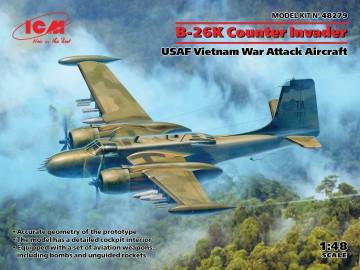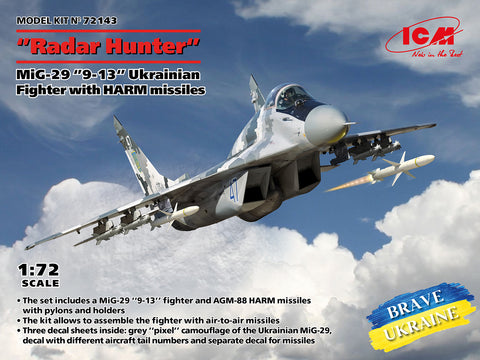
ICM Aircraft 1/48 WWII German He111Z1 Zwilling Glider Tug Aircraft (New Tool) Kit
Estimated Shipping 2-3 Business Days
The development of the He111Z was a direct result of the success of a Messerschmitt design. Messerschmitt had developed a huge cargo glider, the Me321, and there were unfortunately not too many German aircraft in the Luftwaffe that were big and powerful enough to tow it when the Me 321 was fully loaded. Those aircraft capable of doing the job had other duties from which they could not be spared.
An idea was hit upon to take a sturdy airframe already in production and add more power to it, in the form of additional engines, so that it could tow the Me 321. The most obvious way to meet this idea was to develop an existing aircraft further, by extending the wings so that it could hold more engines. The Heinkel staff tackled the problem, but not in the most obvious way. Redesign of an existing aircraft would take a lot of time with testing and production of new and redesigned parts. The Heinkel staff simply took two He111H-6 bombers, cut the starboard wing from the engine to the wingtip off one of them, and the port wing from the engine to the wingtip from the other, added a wing section with an installed engine between the two shortened wings and joined the three parts together. The result was two He 111 fuselages, two tail assemblies, two wings and five big Jumo engines. Since the two fuselages were joined by a common wing, the nickname "twins" stuck, and the He111 variant was given the designation He111Z, for "Zwilling", meaning "twin". The five Jumo engines developed a total of 7,500 horsepower; more than enough to tow the huge Me 321 glider.
The design was radical, yet simple and airworthy. It didn't require a great amount of expense for testing, design and retooling. It was flown from the port fuselage by a standard crew and was capable of 270 miles per hour. It was used from 1942 onwards in small numbers to tow both Me321 gliders and Gotha Go 242 gliders. Two fully loaded Go 242s could be towed for almost 1,000 miles. The range was extended by the gliders themselves, once they were cut loose from the He 111Z and allowed to glide in for their landings.
An idea was hit upon to take a sturdy airframe already in production and add more power to it, in the form of additional engines, so that it could tow the Me 321. The most obvious way to meet this idea was to develop an existing aircraft further, by extending the wings so that it could hold more engines. The Heinkel staff tackled the problem, but not in the most obvious way. Redesign of an existing aircraft would take a lot of time with testing and production of new and redesigned parts. The Heinkel staff simply took two He111H-6 bombers, cut the starboard wing from the engine to the wingtip off one of them, and the port wing from the engine to the wingtip from the other, added a wing section with an installed engine between the two shortened wings and joined the three parts together. The result was two He 111 fuselages, two tail assemblies, two wings and five big Jumo engines. Since the two fuselages were joined by a common wing, the nickname "twins" stuck, and the He111 variant was given the designation He111Z, for "Zwilling", meaning "twin". The five Jumo engines developed a total of 7,500 horsepower; more than enough to tow the huge Me 321 glider.
The design was radical, yet simple and airworthy. It didn't require a great amount of expense for testing, design and retooling. It was flown from the port fuselage by a standard crew and was capable of 270 miles per hour. It was used from 1942 onwards in small numbers to tow both Me321 gliders and Gotha Go 242 gliders. Two fully loaded Go 242s could be towed for almost 1,000 miles. The range was extended by the gliders themselves, once they were cut loose from the He 111Z and allowed to glide in for their landings.




